Japan's Experience and Technology Support Quality Growth
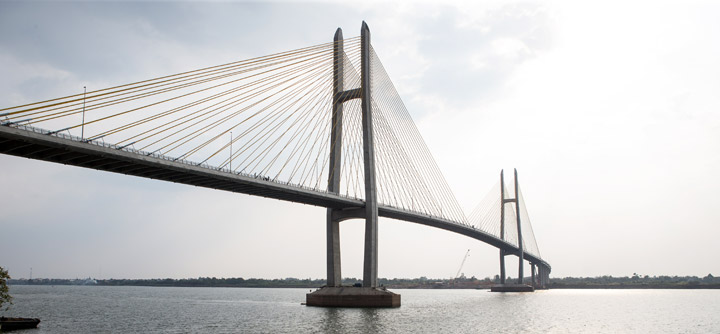
Tsubasa Bridge in Cambodia. Photo by Shinichi Kuno of JICA.
Aug. 8, 2017, is the 50th anniversary of the establishment of the Association of Southeast Asian Nations. Currently the total population of the 10 member nations is 630 million people and their total GDP is US$2.432 trillion. The huge market is expected to be a driver for the world economy.

The ties between Japan and ASEAN, which are geographically close to one another, have been continuing for over 40 years since the start of friendly relations in 1973. Japan and ASEAN have built a relationship of trust. At the end of 2015, the ASEAN Community launched, in a move toward deeper regional ties. The ASEAN Community consists of three pillars: the ASEAN Political-Security Community (APSC), the ASEAN Economic Community (AEC) and the ASEAN Socio-Cultural Community (ASCC).
JICA has been carrying out support to ASEAN that emphasizes connectivity since before the launch of the ASEAN Community so that ASEAN develops as a single region and grows along with Japan. In addition, JICA is engaged in support for the development of high level human resources to bolster the countries and industries of ASEAN, in support to solve urban problems and in support to help create the rules of society to cope with the changing times. JICA is supporting quality growth [1] in ASEAN by putting to work the experiences and technologies of Japan.
For improved regional connectivity and growth
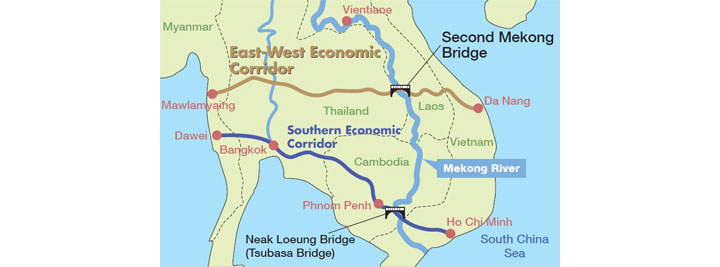
Two corridors within the ASEAN region
Corridors, in which roads and bridges connect major ports and cities, make it possible for regions with poor access and inland districts to develop industrially.
Two corridors bear the burden of connecting the land within the ASEAN region: 1. The East-West Economic Corridor, which stretches from Da Nang, Vietnam, to Mawlamyine, Myanmar, and 2. the Southern Economic Corridor, which runs from Ho Chi Minh City, the largest city in Vietnam, through Phnom Penh, the capital of Cambodia, and Bangkok, the capital of Thailand, to Dawei, Myanmar.
JICA provides support for road repairs and improvements to ports and tunnels in various locations. In addition, JICA provided assistance to build two bridges on the Mekong River, invigorating the flow of people and goods.
Laos: The Second Thai-Lao Friendship Bridge spans the East-West Economic Corridor
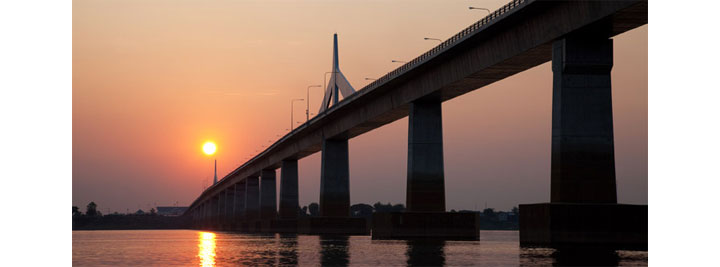
The Second Thai-Lao Friendship Bridge is a strategic point for transportation.
It has been ten years since the Second Thai-Lao Friendship Bridge opened in December 2006. The bridge, which connects Thailand and Laos, promotes cross-border educational and employment opportunities between the two countries. Daily traffic has increased approximately eightfold between 2009 and 2015, going from 256 vehicles to 1,947.
Cambodia: The Tsubasa Bridge spans the Southern Economic Corridor
The Tsubasa Bride, which connects Cambodia to Ho Chi Minh City, the largest city in neighboring Vietnam, opened in April 2015. It used to be necessary to wait for up to seven or eight hours to board a ferry, but now it is possible to cross the river in five minutes. The corridor connects to the Thai capital of Bangkok to the west, and is expected to be a major artery supporting international distribution.
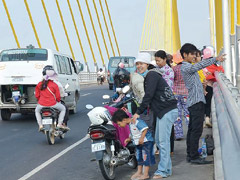
Residents rejoice at the opening of Tsubasa Bridge.
Vietnam and Myanmar: The latest Japanese technology contributes to smoother trade
In Vietnam, imports and exports are growing rapidly. JICA is supporting an initiative to smooth distribution by applying a Japanese IT system for customs to Vietnam. Currently some 66,000 importers and exporters are benefiting from it. JICA is also supporting the adoption of the system in Myanmar.
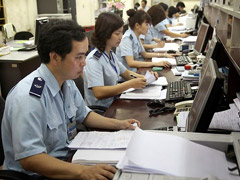
Customs workers in Vietnam perform procedures related to customs clearance. The business environment is being improved by a new system.
Drawing a future map of the city, the key to development
To cope with rapid urbanization due to development and population growth, many measures are required. These include countermeasures for housing problems, urban transport, water and sewage services, waste processing and pollution. JICA is providing comprehensive support for everything from planning to implementation.
The Philippines: The road to realizing Mega Cebu Vision 2050, and partnership with Yokohama
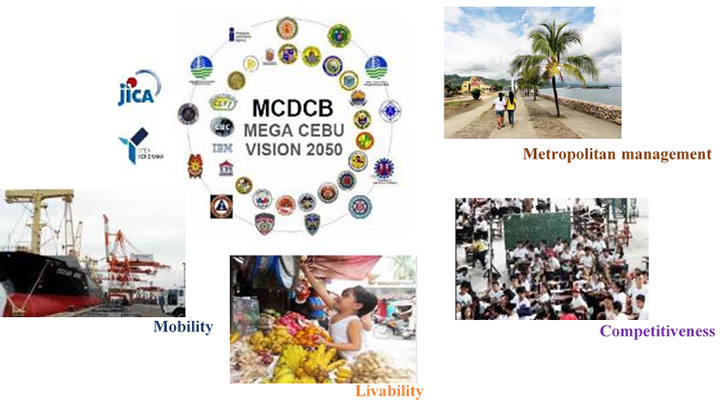
Metro Cebu is the No. 2 urban area in the Philippines. It has abundant tourism resources, including beautiful beaches, and striking population growth. However, the fragile urban base and frequent flood damage are obstructing development. JICA partnered with the city of Yokohama, which has also developed as a harbor city, to provide assistance in creating the urban development vision Mega Cebu Vision 2050 and a roadmap for realizing that vision. This is the first case in which JICA has partnered with a local government on an overall urban plan in a foreign country.
Graphic caption: The Mega Cebu Vision 2050 is made up of the following four strategies: competitiveness, livability, mobility and metropolitan management. JICA and the city of Yokohama are providing support for achieving the Vision, which is being advanced by the 13 cities and towns that make up the Metro Cebu metropolitan area, central government agencies, the private sector and civil society, all working as one.
Related Links
Reporting by media from various ASEAN countries, and Japan's initiatives on urban problems
The Invitation Program of Media Representatives to Japan aims to deepen understanding of JICA projects and of Japan. In June 2017, newspaper reporters from 10 ASEAN member countries visited Japan to report on initiatives on urban problems and disaster risk reduction.
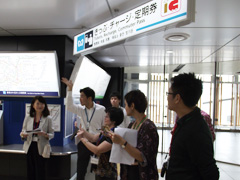
A Tokyo Metro training facility
Developing the people who will serve as a bridge between ASEAN and Japan
JICA's assistance efforts are getting great results with regard to developing the high-level human resources needed for further growth in ASEAN. These include next-generation leaders, policy-makers and industrial personnel tasked with technological innovation. This assistance will contribute to stronger friendly ties between Japan and ASEAN.
Universities in Japan and ASEAN partner to support the development of engineering personnel
ASEAN University Network/Southeast Asia Engineering Education Development Network (AUN/SEED-Net) is an educational project to improve the network among universities in Japan and ASEAN and improve the capacity of ASEAN university faculty in ten engineering fields including civil and environmental engineering. It not only makes it possible to earn an advanced degree, it aims to advance research on issues common to the region such as industrial development and climate change.
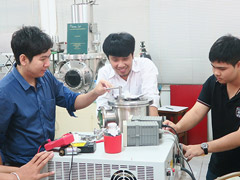
Researchers from multiple countries together take on issues common to the region.
Singapore: 20 years' partnership towards ASEAN integration
Since its independence, Singapore has become one of the richest and most stable countries in the world while making use of assistance from Japan and the international community.
In 1997, Japan and Singapore launched the Japan-Singapore Partnership Programme for the 21st Century (JSPP21) to share their accumulated expertise and knowledge on development with ASEAN member countries and other developing countries. Over the course of 20 years, JICA and Singaporean Ministry of Foreign Affairs (MFA) have jointly organized 380 training courses, mainly in Singapore. More than 6,600 people have participated in them.
In view of the 50th anniversary of the establishment of ASEAN and Singapore's ASEAN chairmanship in 2018, the governments of Japan and Singapore agreed to continue focusing JSPP21 training courses primarily on ASEAN member countries' needs and to make the following priority areas: security and peace, connectivity, private sector development, and disaster risk reduction and management. Accordingly, JICA and MFA will carry out 10 courses in 2017. They will include maritime safety, community policing and urban development.
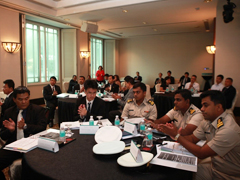
Maritime safety management training has been being carried out for more than 10 years.
Vietnam-Japan University opens, aims to be a base for world-class human resource development
Vietnam-Japan University opened in September 2016 after the two countries' governments laid the groundwork. With an educational program that is cross-disciplinary, encompassing both literature and science, it is cultivating a broad range of human resources of the kind needed in Japan and Vietnam. JICA supported the establishment of six master's degree courses of different specializations. It is currently carrying out a survey for the sequential establishment of bachelor's and doctoral courses, and aims to make it a comprehensive, world-class university with around 6,000 students.
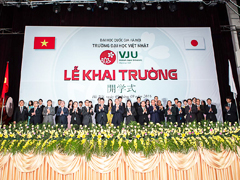
The university's opening ceremony
Participants in training in Japan help build up the country of Vietnam
At the National Congress of the Communist Party of Vietnam held in January 2016, 33 of the 100 people selected to be members of the central committee were past participants in the National Leader Candidate Training conducted by JICA and its partners.
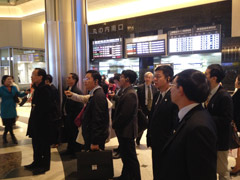
Training in Japan. At East Japan Railway Company, participants learned about post-privatization station area development.
Innovative Asia, which promotes innovation through science and technology, begins in 2017!
A new initiative called Innovative Asia gets underway in September 2017. Over the course of five years, 1,000 students will go to Japan to study. These students are engaged in science and technology research at universities in 12 Asian countries, including not only ASEAN, but also India, Sri Lanka and others. After they have completed their studies at Japanese universities, they are expected to contribute to promoting innovation in their fields. The scholarship program aims to enhance the circulation of competent human resources between Japan and Asian countries and to promote friendly relations between Japan and the other countries.
Making rules to cope with a new era and new developments
Since 1868 - the start of the Meiji period during which Japan modernized and opened itself to the outside world ? the country has been creating its own legal culture by incorporating customized elements of European and U.S. law. Now JICA is putting that experience to work to build up the nations of Laos and Myanmar.
Laos: Using handbooks to make laws appropriate to today more understandable
Laos, which joined ASEAN in 1997, is now in the process of converting to a market economy. In addition to supporting legal reform to make that happen, JICA created handbooks and a collection of Q&As to support the education of a wide range of lawyers. The preparation of labor laws, economics-related laws and other statutes will lead to the creation of an environment that makes it easy to do business, and is beneficial for the entry of foreign companies.
Related Link
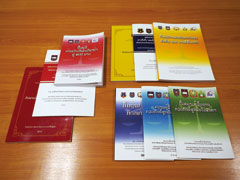
The legal handbooks. They are highly regarded by legal practitioners.
Myanmar: Breaking away from an unchangeable body of law, for the people who live in a new era
After a prolonged period of military rule, a new government got its start in Myanmar in 2011. The legal system there today has been in place for more than 100 years. JICA began providing support in 2013 to lay the groundwork for wide-ranging debate on bills and to develop human resources with sufficient knowledge. Discussions with experts and training that assumed specific disputes were an opportunity to think about whether draft laws are appropriate to Myanmar today. As a result, changes in the way judges and government workers think are gradually becoming apparent.
Related Link
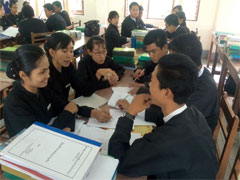
Training for new judges at a training facility at the Supreme Court
Note
[1] Quality growth is one of the objectives the Sustainable Development Goals (SDGs) are attempting to achieve. It emphasizes growth that includes three things: 1. "inclusiveness," in which the fruits of growth go to society as a whole and no one is left behind 2. intergenerational "sustainability," which includes consideration for the environment and society and measures to fight climate change, and 3. resilience, or abundant ability to withstand various shocks such as economic crises and natural disasters.




scroll